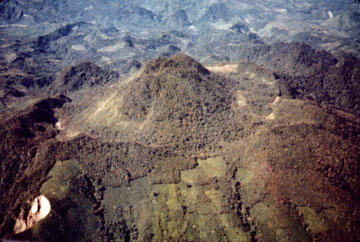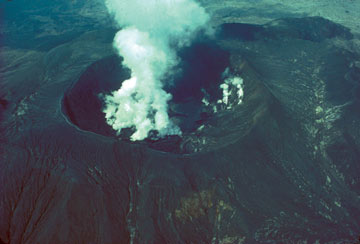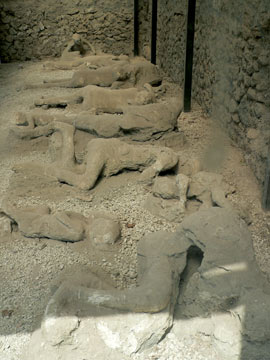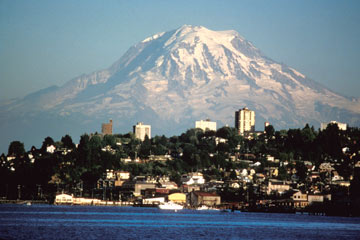|
FEATURE
Danger Lurks Deep: The Human Impact of Volcanoes
Joanne Feldman and Robert I. Tilling
Volcanic Fatalities Print Exclusive
 René Canul, Comisión Federal de Electricidad |
| Above: This aerial photo of the summit of Mexico’s El Chichón volcano was taken in March 1981. Below: By March and April 1982, a new kilometer-wide crater had replaced the summit cone, which was blasted away by a series of explosive eruptions that killed 2,000 people and wiped out nine villages in Mexico’s worst recorded volcanic disaster. |
 Robert I. Tilling |
Near midnight of March 28, 1982, El Chichón — an obscure, little-studied volcano in Chiapas State, southern Mexico — violently erupted, terrifying local villagers and prompting a confused, poorly executed evacuation. For the next five days, the volcano remained intermittently but only weakly active, so many evacuees were allowed to return to their homes. Then, on April 3 and 4, two powerful and lethal eruptions occurred. Ground-hugging, high-speed torrents of hot gas and burning rock fragments swept down all sides of the volcano, obliterating everything in their paths. The eruptions killed about 2,000 people, mostly because of pyroclastic flows and surges that devastated nine villages around the volcano. Associated falling ash caused roofs to collapse, destroyed infrastructure and crops, and decreased visibility, necessitating road and airport closures. In addition to the fatalities, the eruptions caused severe socioeconomic hardships and disrupted the daily lives of many more thousands of people in the surrounding regions. Moreover, an unusually large amount of sulfur dioxide gas was injected into the atmosphere, which circled the planet over the next 20 days, affecting air traffic worldwide and slightly cooling the planet for more than two months after the eruption.
These eruptions produced the worst volcanic disaster in the recorded history of Mexico. Tragically, because early warnings in 1980 and 1981 of the volcano’s possible reawakening — for example, increased steaming and earthquakes felt by villagers — went unheeded, El Chichón’s deadly eruptions came almost as a total surprise to scientists and government officials alike.
Volcanic eruptions — compared to other natural phenomena — occur infrequently, yet have the potential to unleash some of the most destructive forces on Earth. Although volcanic eruptions have killed approximately 300,000 people in the past 400 years, the cause of death and exact number of fatalities are not well-documented. Yet with more than 500 million people, or about 10 percent of the world’s population, living within 100 kilometers of a historically active volcano, understanding how people die and are injured during volcanic eruptions may help mitigate future volcanic disasters.
On average, about 50 to 70 eruptions occur worldwide each year, and two to four of these cause serious injuries or deaths. Most volcano-related fatalities, injuries and psychosocial effects occur when a volcano erupts violently and suddenly, leaving little or no time for people to escape or take shelter. Looking back at the volcanic eruptions we can track, it appears that pyroclastic flows and surges, mud flows (lahars), volcano-induced tsunamis, debris avalanches, fall and accumulation of rock fragments and, more rarely, toxic gases and lava flows together are responsible for approximately 70 percent of volcano-associated fatalities. The remainder of the deaths, at least historically, has been caused by post-eruption famine and disease epidemics (see sidebar, Print Exclusive).
Pyroclastic Flows
Pyroclastic flows and surges cause most of the fatalities directly associated with an erupting volcano. These hot, high-speed, ground-hugging mixtures of ash, volcanic gases, lava fragments and heated air travel at speeds greater than 300 kilometers per hour (186 miles per hour), with temperatures of up to 900 degrees Celsius (1,650 degrees Fahrenheit). People engulfed by a pyroclastic flow typically die from asphyxiation due to inhaling ash or oxygen deprivation, exposure to the intense heat, massive thermal burns, burial under volcanic debris or fatal traumatic injuries from associated high-energy blasts that displace trees, buildings and rocks. Survivors often have extensive severe burns to their skin and respiratory tracts, and blunt-force trauma injuries. Subsequent eruption-induced fires can cause further injury and death, and ash deposits can remain extremely hot for weeks, posing a lingering danger.
Pyroclastic flows and surges caused the devastation associated with the famous eruption of Vesuvius near Naples, Italy, in A.D. 79. This eruption was the first well-documented historical volcanic event to devastate a populated region, killing thousands of people, most notably in Pompeii and Herculaneum. Remains of more than 2,000 people found amid the ruins reveal that hot volcanic ash and gases instantaneously suffocated many of the victims. Other victims showed evidence of traumatic injuries, as the force of the explosion and pyroclastic flows hurled rocks and building materials. Skeletons recently uncovered in beach caves in Herculaneum suggested that intense heat — roughly 500 degrees Celsius (930 degrees Fahrenheit) — caused immediate death.
 Simon Pocock |
| The A.D. 79 eruption of Mount Vesuvius in Italy marks the first major volcanic eruption that was well-documented. The several thousand people who lived in Pompeii and Herculaneum are thought to have perished from suffocation due to hot volcanic ash and gases, blunt-force trauma from the force of the explosion, pyroclastic flows burying them, and intense heat cooking them and killing them instantly. |
More recently, the 1902 eruption of Montagne Pelée on the Caribbean island of Martinique sent pyroclastic flows moving faster than 100 kilometers per hour (62 miles per hour) down the mountainside. Within minutes, the city of Saint Pierre, six kilometers away, was annihilated and about 29,000 people were killed. Similarly, the May 18, 1980, eruption of Mount St. Helens created a high-speed pyroclastic surge that swept down its flanks, instantly killing 57 people from asphyxiation, burns, burial under volcanic debris and from fatal traumatic injuries due to hurricane-force winds, which felled trees and displaced rocks.
Lahars
Lahars, an Indonesian term for volcanic mudflows, are rapidly moving, dense slurries that form when water mixes with hot or cold volcanic debris. Mudflows commonly have a consistency of wet concrete and are extremely dangerous, because they can form during an eruption, after an eruption or can be generated by non-eruptive causes, such as heavy rainfall and earthquakes. Additionally, they often come unheralded and may reach areas far from the lahar source. Human settlements in the path of these rapidly moving mudflows can be quickly buried.
In 1985, the deadliest lahars in historical times destroyed the Colombian town of Armero, killing about 23,000 people. The lahars were triggered after a small pyroclastic flow melted the summit snowcap of Nevado del Ruiz Volcano, and the resulting meltwater combined with volcanic ash and swept down the volcano’s steep valleys through its rivers. Around midnight, 50 kilometers away from the volcano, the lahars struck Armero, covering the area up to four meters deep with mud, and burying three-quarters of the population. Inhabitants died due to suffocation from breathing in the mud, traumatic injuries, severe dehydration or blood loss and complications with gangrene. Of the survivors, many suffered lacerations, penetration wounds, fractures and eye injuries.
Tsunamis
Tsunamis are seismic sea waves triggered by sudden land movements caused by earthquakes or volcanic activity — specifically by eruptions of undersea volcanoes and volcano-induced debris avalanches. Though relatively infrequent, tsunamis pose a severe risk to low-lying coastal areas, as illustrated by the earthquake in Sumatra in December 2004 that generated tsunamis across the Indian Ocean with waves up to 15 meters high that killed approximately 250,000 people. Tsunamis caused by volcanic activity can be equally devastating. More than 42,500 people have been killed by volcano-induced tsunamis — that we can count. Most of these fatalities resulted from the famous eruption of Indonesia’s Krakatau in 1883, when pyroclastic flows emptied into the sea, displacing the water and setting off a series of tsunamis that washed away 165 coastal villages on Java and Sumatra, killing 36,000 people. Injuries and causes of death include drowning and blunt-force trauma, as massive amounts of water inundate human settlements.
Steep-sided composite volcanoes especially can pose a danger as they can be the site of catastrophic avalanches of rock and ash that can sweep down the mountain and quickly bury towns located near the volcano. If debris empties into the sea and enough water is displaced, devastating tsunamis may form. In 1792, a debris avalanche at Mount Unzen in Japan swept down the side of the volcano, killing thousands before emptying into the sea and setting off devastating tsunamis that killed more than 15,000 more people. Victims that were buried in the debris suffocated and/or suffered blunt-force trauma injuries.
Tephra
Tephra, the general term for fragmented rocks of any size ejected into the air by volcanic explosions, includes shattered pre-existing rock, volcanic bombs and blocks (shot up from below the surface), glass shards, pumice and ash. Large-sized tephra can cause significant human injury on impact, including lacerations and blunt-force trauma to the head, chest and abdomen. Fortunately, the danger zone of large-size tephra is limited to within a few kilometers of the source (the maximum recorded range is five kilometers). However, incandescent flying ejecta — similar to embers popped out of a campfire — can set fire to wooden structures, forests or grassland and thus present a significant hazard. Smaller-sized tephra, especially ash, is much more dangerous, as volcanic ash can drift and be deposited hundreds to thousands of kilometers downwind from a volcano.
Ash
Inhalation of ash, typically seen as a significant health hazard, is for the most part relatively benign, except for people with pre-existing lung conditions and those who work outside and thus would face greater exposure. Ash is a relatively benign substance — meaning it is not usually the primary cause of pneumonia or other respiratory diseases — because its particles are generally too large to be inhaled and high-dust concentrations do not last long. But fine ash particles, those less than 10 micrometers in diameter, can irritate the lungs and are especially dangerous for people with asthma, chronic bronchitis and emphysema. After Mount St. Helens erupted in 1980, there was a four-fold increase in the number of asthma patients and a two-fold increase in the number of bronchitis patients visiting emergency departments in two nearby large hospitals. No study, however, has shown long-term consequences of regularly breathing ash, even, for example, in the densely populated regions around Mount Sakurajima in Kyushu, Japan, where persistent small eruptions occur hundreds of times each year.
Ash causes other problems, though, such as eye irritations, which can lead to cases of conjunctivitis or corneal abrasions, especially for those wearing contact lenses. But treatment is simple and does not pose a serious problem. Of much greater concern is the risk to housing — and thus people — from ash fall. As little as 10 centimeters of ash lying on a flat roof can cause its collapse, especially if the ash gets wet from rainfall. Approximately 10,000 recorded fatalities have been directly associated with ash fall, and the majority of these are from such roof collapses. In 1991, the climactic eruption of Mount Pinatubo in the Philippines occurred during an untimely typhoon. Collapse of ash-laden roofs wet from rain killed at least 300 people. Also, during times of heavy ash fall, the incidences of motor vehicle accidents — and associated injuries — increase as visibility decreases and roads become slippery with ash.
One of the most severe problems with ash, however, is a longer-lasting issue: Heavy ash can strip leaves from vegetation and coat the few surviving leaves, thus destroying vegetation and crops. Such destruction in turn leads to starvation of livestock and, ultimately, to famine in areas dependent on agriculture for sustenance. Famine from ash-related destruction of crops was the number one cause of fatalities associated with volcanic eruptions before the 20th century. In fact, the largest historical eruption on Earth, the 1815 eruption of Tambora in Indonesia, was also the deadliest. More than 82,000 people died from starvation and disease after large quantities of ash killed all the crops and vegetation in surrounding regions. (Another 10,000 people died directly from pyroclastic flows and tephra.)
Gases
Carbon dioxide and hydrogen sulfide are the most dangerous toxic gases released during volcanic activity, though other volcanic gases, such as sulfur dioxide and hydrogen fluoride, can cause problems as well. Denser than air, both carbon dioxide and hydrogen sulfide can collect in low-lying areas and cause problems. Carbon dioxide is an asphyxiant, and at concentrations higher than 20 to 30 percent can, if inhaled, very quickly cause unconsciousness and death. Hydrogen sulfide, a colorless gas that smells like rotten eggs, is so toxic that a high-level exposure can kill a human after a single breath. Sulfur dioxide is an irritant to mucous membranes and can induce respiratory problems, but has never been proven to directly cause death. Similarly, there are no fatalities directly associated with hydrogen fluoride, but the gas was indirectly responsible for the deaths of 10,000 Icelanders in 1783. Sustained emissions of hydrogen fluoride from the prolonged Laki fissure eruption poisoned much of the pastureland and crops, causing the deaths of half of Iceland’s livestock and causing crop failure, which ultimately led to famine and death (see Geotimes, June 2007).
Lava Flows
Contrary to popular belief and cinemagraphic exaggerations, lava flows are rarely dangerous to humans and only account for about 0.3 percent of total deaths from historical volcanic activity. Typically slow moving, lava flows can be outrun (think about Kilauea in Hawaii, with its picturesque slow-moving fingers of lava reaching into the sea). If not outrun, skin and respiratory tract burns may occur directly upon contact with the lava, or indirectly from scalding steam or explosions as lava overruns vegetation, ice, snow or water.
 Lyn Topinka, U.S. Geological Survey |
| Mount Rainier looms behind Tacoma, Wash., a constant reminder of the danger the volcano poses to the millions of people living in its shadow. New research is aiming to determine just how at-risk people are from volcanoes around the world. |
The most deadly single lava flow occurred during the 1977 eruption of Mount Nyiragongo in the Congo, when a summit lava lake suddenly drained through fissures in the crater wall. A very fluid lava flow, estimated to be traveling at 100 kilometers per hour (62 miles per hour), swiftly engulfed small towns downslope, killing hundreds of people.
Long-term Effects
Major eruptions continue to have hazardous impacts long after activity ceases. Large quantities of ash and gases released into the atmosphere can contaminate water supplies, destroy crops, cause air pollution, produce acid rain, deplete the ozone and potentially affect global climate for years. For instance, after the deadliest volcanic eruption in history, the 1815 Tambora eruption, 82,000 people died in worldwide famines and disease epidemics. Furthermore, due to the volcano's eruptive column reaching 43 kilometers high, average global temperatures were reduced by 3 degrees Celsius (5.4 degrees Fahrenheit) for several years. Because of these eruption-induced impacts, 1816 was called “the year without summer.” This temperature change spawned a typhus epidemic in Great Britain, cholera in India, mass migration from northern Europe and Russia and ruined farms in New England, spurring Americans to head west.
Compared with other natural hazards, volcanic eruptions only account for some 2 percent of all natural disasters, affect few people and are responsible for only a small percentage of fatalities. However, large explosive volcanic eruptions have the potential to cause catastrophic local and worldwide consequences. Few people survive deadly pyroclastic flows, lahars and volcano-induced tsunamis. In fact, the dead-to-injured ratio is so dismal that evacuation prior to the eruption is the only way to truly mitigate the risk from volcano hazards.
In order to evacuate, volcanoes need to be monitored for premonitory events, such as earthquakes and other measurable phenomena, and disaster plans created and implemented before a volcanic crisis (see story, this issue). This approach takes a tremendous amount of resources and cooperation, but it works. Fewer than 400 people died from the explosive eruptions of Mount St. Helens in 1980 and Mount Pinatubo in 1991, because these volcanoes were well-monitored and high-risk zones around the volcanoes were evacuated prior to their eruptions. With one-tenth of the world’s population living near volcanoes — many on the volcano slopes themselves, or on the remains of a previous pyroclastic flow, lahar or debris avalanche — a strategy of volcano hazards assessment, volcano monitoring and effective communications between scientists and emergency-management authorities will help mitigate future volcanic disasters.
Links:
"June 8, 1783: Laki Erupts, Killing Thousands," Geotimes, June 2007 Print Exclusive
"When Volcanoes Threaten, Scientists Warn," Geotimes, November 2007 Print Exclusive

 Subscribe
Subscribe


